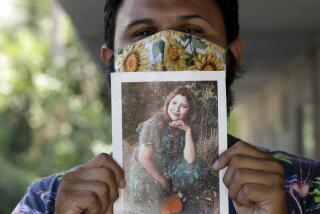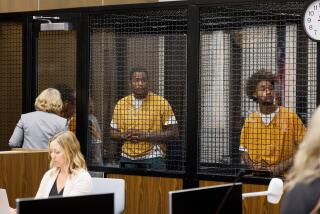High Court Upholds Death Sentence for Murders at Market
SAN FRANCISCO — The state Supreme Court on Monday unanimously upheld the death sentence of a one-time Buddhist monk convicted in the 1981 robbery-murders of a Garden Grove market manager and her clerk.
The justices rejected the appeal of Jarutun Siripongs, now 36, a native of Thailand who had been portrayed by his defense lawyer as a nonviolent man who prayed each morning before going to work at an Irvine optical firm.
Siripongs, who came to the United States in 1980, was found guilty and sentenced to death for the strangulation murder of Packovan (Pat) Wattanaporn of Huntington Beach, who ran the store at which the defendant once worked, and the fatal stabbing of Quach Nguyen of Westminster.
According to evidence presented at his trial, Siripongs stole an estimated $25,000 in jewelry and other items in a robbery at the market, hiding some of the items and trying to sell others. He was arrested at a local department store when he tried to use Wattanaporn’s credit card to buy a television set.
Impact of Killings
In an opinion by Chief Justice Malcolm M. Lucas, the court refused to set aside the death sentence on grounds that the trial prosecutor made inflammatory and irrelevant remarks to jurors on the impact of the killings on the victims’ families.
In his closing argument, Orange County Assistant Dist. Atty. Edgar A. Freeman told jurors that the killings were “horrendous” and involved “not just the enormity of taking one’s life . . . but the impact that is left on those who survive--the near and dear.
“Victims have rights to be recognized and to be listened to and to be addressed by jurors. And jurors must have the courage, if the evidence warrants it, to impose a death penalty if that’s what the law is and that’s what the evidence directs.”
The justices acknowledged that the U.S. Supreme Court last year barred the presentation of evidence to jurors on the impact of a crime on the victim’s family. But in this case, Lucas wrote, there was no such evidence presented, and the prosecutor’s remarks were “brief and mild.”
Siripongs’ is the third Orange County death penalty case to be upheld by the Lucas court.
The first was James Melton, 36, on March 3. Melton was convicted of the 1981 killing of a Newport Beach hairdresser during a robbery.
The second was Thomas M. Thompson, 33, on April 28. Thompson was convicted of the 1981 killing of a girlfriend for his best friend and co-defendant. The co-defendant, David Lietch, was tried separately and was convicted of second-degree murder. He was sentenced to 15 years to life in prison.
The justices on Monday also held it was proper for the trial judge, Orange County Superior Court Judge Robert R. Fitzgerald, to hear pleas for the death penalty from the victims’ family members, as permitted under a 1982 initiative known as the “victims’ bill of rights.”
Wattanaporn’s husband, the father of their four children, and her 15-year-old son made tearful statements to Fitzgerald, urging that Siripongs pay for the crimes with his life.
Heard Pleas
However, the judge heard their pleas after refusing to reduce Siripongs’ sentence to life without parole, indicating that their statements did not change his mind, the court noted. Also, Lucas said, it was “doubtful” that the U.S. Supreme Court intended to bar victims’ family members from making statements to trial judges, “who are presumably capable of retaining objectivity” in deciding whether to impose the death penalty.
In a concurring opinion, Justice Stanley Mosk warned that even though the the error in this case was harmless, no reference at all should be made to jurors on the impact of a crime on the victims’ families. The purpose of presenting either evidence or argument was the same: “to inflame the jury,” Mosk said.
Justice Allen E. Broussard issued a brief concurring opinion, saying he supported Mosk’s views.
California Deputy Atty. Gen. Louis R. Hanoian called the ruling “an appropriate and correct one” and said that Freeman’s remarks on the impact on victims had not been intended to inflame the jury.
“This was not a situation where the prosecutor was banging on the table,” he said.
Hanoian said that, since the U.S. Supreme Court’s ruling, it was “safe to assume” that prosecutors now were avoiding any comment on the victim’s impact issue before jurors to make sure that there was no violation of the high court’s mandate.
The ruling is expected to be appealed to the U.S. Supreme Court.
Monday’s decision marked the 20th time the court has upheld a death sentence in the 28 capital cases that it has ruled on since three new justices appointed by Gov. George Deukmejian joined the court in March, 1987.
According to testimony in the case, Wattanaporn, the wife of a wholesale import-export businessman, bought and sold expensive jewelry in addition to working at the market. Siripongs, a former employee, knew that she frequently wore such jewelry to work and kept other pieces in her purse, the prosecution contended.
On the day of the murders, the two victims were found dead in a blood-spattered storeroom. Jack Wattanaporn, the husband of the store owner, told investigators that Siripongs had a criminal record while in Thailand and might be responsible.
Two days later, Siripongs was taken into custody by security guards at the department store after he tried to make a purchase with the victim’s credit card.
At trial, Siripongs’ defense attorney called no witnesses, contending that the prosecution, with a case based largely on circumstantial evidence, had failed to show the defendant guilty beyond a reasonable doubt.
Citing testimony by prosecution witnesses, Deputy Public Defender James P. Spellman described Siripongs as a hard-working, deeply religious man. Arguing that the defendant should not be sentenced to death, Spellman called Siripongs a “good” and “caring” man who had caused no trouble while being held in jail and who was a “model prisoner.”
Times staff writer Jerry Hicks contributed to this story from Orange County .
More to Read
Sign up for Essential California
The most important California stories and recommendations in your inbox every morning.
You may occasionally receive promotional content from the Los Angeles Times.










